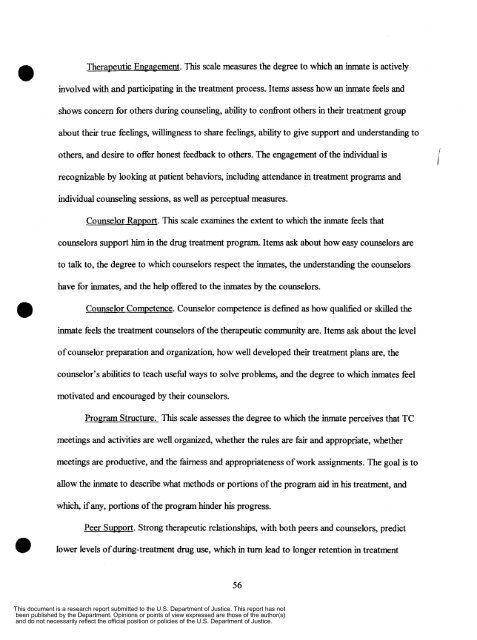0 - National Criminal Justice Reference Service
0 - National Criminal Justice Reference Service
0 - National Criminal Justice Reference Service
Create successful ePaper yourself
Turn your PDF publications into a flip-book with our unique Google optimized e-Paper software.
0<br />
TheraDeutic Engagement. This scale measures the degree to which an b t e is actively<br />
involved with and participating in the treatment process. Items assess how (an inmate feels and<br />
shows concern for others during counseling, ability to confiont others in their treatment group<br />
about their true feelings, willingness to share feelings, ability to give support and understanding to<br />
others, and desire to offer honest feedback to others. The engagement of the individual is<br />
recognizable by looking at patient behaviors, including attendance in treatment programs and<br />
i<br />
individual counseling sessions, as well as perceptual measures.<br />
Counselor Rapport. This scale examines the extent to which the inmate feels that<br />
counselors support him in the drug treatment program. Items ask about how easy counselors are<br />
to talk to, the degree to which counselors respect the inmates, the understanding the counselors<br />
0<br />
have for inmates, and the help offered to the inmates by the counselors.<br />
Counselor Competence. Counselor competence is defined as how qualified or skilled the<br />
inmate feels the treatment counselors of the therapeutic community are. Items ask about the level<br />
of counselor preparation and organization, how well developed their treatment plans are, the<br />
counselor’s abilities to teach useful ways to solve problems, and the degree to which inmates feel<br />
motivated and encouraged by their counselors.<br />
Program Structure. This scale assesses the degree to which the inmate perceives that TC<br />
meetings and activities are well organized, whether the rules are fair and appropriate, whether<br />
meetings are productive, and the fairness and appropriateness of work assignments. The goal is to<br />
allow the inmate to describe what methods or portions of the program aid in his treatment, and<br />
which, if any, portions of the program hinder his progress.<br />
Peer Support. Strong therapeutic relationships, with both peers and counselors, predict<br />
0 lower levels of during-treatment drug use, which in turn Iead to longer retention in treatment<br />
56<br />
This document is a research report submitted to the U.S. Department of <strong>Justice</strong>. This report has not<br />
been published by the Department. Opinions or points of view expressed are those of the author(s)<br />
and do not necessarily reflect the official position or policies of the U.S. Department of <strong>Justice</strong>.
















